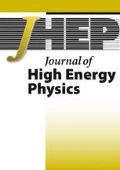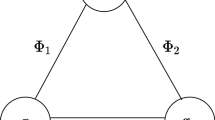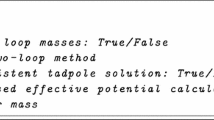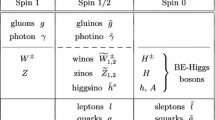Abstract
We study the theoretical and phenomenological consequences of modifying the Kähler potential of the MSSM two Higgs doublet sector. Such modifications naturally arise when the Higgs sector mixes with a quasi-hidden conformal sector, as in some F-theory GUT models. In the Delta-deformed Supersymmetric Standard Model (DSSM), the Higgs fields are operators with non-trivial scaling dimension 1 < Δ < 2. The Kähler metric is singular at the origin of field space due to the presence of quasi-hidden sector states which get their mass from the Higgs vevs. The presence of these extra states leads to the fact that even as Δ → 1, the DSSM does not reduce to the MSSM. In particular, the Higgs can naturally be heavier than the W - and Z-bosons. Perturbative gauge coupling unification, a large top quark Yukawa, and consistency with precision electroweak can all be maintained for Δ close to unity. Moreover, such values of Δ can naturally be obtained in string-motivated constructions. The quasi-hidden sector generically contains states charged under SU(5)GUT as well as gauge singlets, leading to a rich, albeit model-dependent, collider phenomenology.
Similar content being viewed by others
References
J.J. Heckman and C. Vafa, An exceptional sector for F-theory GUTs, Phys. Rev. D 83 (2011) 026006 [arXiv:1006.5459] [INSPIRE].
J.J. Heckman, Y. Tachikawa, C. Vafa and B. Wecht, N = 1 SCFTs from brane monodromy, JHEP 11 (2010) 132 [arXiv:1009.0017] [INSPIRE].
S. Cecotti, C. Cordova, J.J. Heckman and C. Vafa, T-Branes and Monodromy, JHEP 07 (2011) 030 [arXiv:1010.5780] [INSPIRE].
J.J. Heckman and S.-J. Rey, Baryon and dark matter genesis from strongly coupled strings, JHEP 06 (2011) 120 [arXiv:1102.5346] [INSPIRE].
J.J. Heckman, C. Vafa and B. Wecht, The conformal sector of F-theory GUTs, JHEP 07 (2011) 075 [arXiv:1103.3287] [INSPIRE].
D. Stancato and J. Terning, The unhiggs, JHEP 11 (2009) 101 [arXiv:0807.3961] [INSPIRE].
A. Azatov, J. Galloway and M.A. Luty, Superconformal technicolor, arXiv:1106.3346 [INSPIRE].
A. Azatov, J. Galloway and M.A. Luty, Superconformal technicolor: models and phenomenology, arXiv:1106.4815 [INSPIRE].
T. Gherghetta and A. Pomarol, A distorted MSSM Higgs sector from low-scale strong dynamics, JHEP 12 (2011) 069 [arXiv:1107.4697] [INSPIRE].
R. Rattazzi, V.S. Rychkov, E. Tonni and A. Vichi, Bounding scalar operator dimensions in 4D CFT, JHEP 12 (2008) 031 [arXiv:0807.0004] [INSPIRE].
D. Poland and D. Simmons-Duffin, Bounds on 4D conformal and superconformal field theories, JHEP 05 (2011) 017 [arXiv:1009.2087] [INSPIRE].
A. Fitzpatrick and D. Shih, Anomalous dimensions of non-chiral operators from AdS/CFT, JHEP 10 (2011) 113 [arXiv:1104.5013] [INSPIRE].
M.A. Luty, J. Terning and A.K. Grant, Electroweak symmetry breaking by strong supersymmetric dynamics at the TeV scale, Phys. Rev. D 63 (2001) 075001 [hep-ph/0006224] [INSPIRE].
R. Harnik, G.D. Kribs, D.T. Larson and H. Murayama, The minimal supersymmetric fat Higgs model, Phys. Rev. D 70 (2004) 015002 [hep-ph/0311349] [INSPIRE].
D. Stancato and J. Terning, Constraints on the unhiggs model from top quark decay, Phys. Rev. D 81 (2010) 115012 [arXiv:1002.1694] [INSPIRE].
H. Fukushima, R. Kitano and M. Yamaguchi, Super-Topcolor, JHEP 01 (2011) 111 [arXiv:1012.5394] [INSPIRE].
N. Craig, D. Stolarski and J. Thaler, A fat Higgs with a magnetic personality, arXiv:1106.2164 [INSPIRE].
I. Donkin and A. Hebecker, Precision gauge unification from extra Yukawa couplings, JHEP 09 (2010) 044 [arXiv:1007.3990] [INSPIRE].
M.J. Strassler and K.M. Zurek, Echoes of a hidden valley at hadron colliders, Phys. Lett. B 651 (2007) 374 DOI:dx.doi.org [hep-ph/0604261] [INSPIRE].
M.J. Strassler, Why unparticle models with mass gaps are examples of hidden valleys, arXiv:0801.0629 [INSPIRE].
G. Cacciapaglia, G. Marandella and J. Terning, Colored unparticles, JHEP 01 (2008) 070 [arXiv:0708.0005] [INSPIRE].
G. Cacciapaglia, G. Marandella and J. Terning, The AdS/CFT/unparticle correspondence, JHEP 02 (2009) 049 [arXiv:0804.0424] [INSPIRE].
H. Cai, H.-C. Cheng, A.D. Medina and J. Terning, Continuum superpartners from supersymmetric unparticles, Phys. Rev. D 80 (2009) 115009 [arXiv:0910.3925] [INSPIRE].
H. Cai, H.-C. Cheng, A.D. Medina and J. Terning, SUSY hidden in the continuum, arXiv:1108.3574 [INSPIRE].
I. Buchbinder, S. Kuzenko and Z. Yarevskaya, Supersymmetric effective potential: superfield approach, Nucl. Phys. B 411 (1994) 665 [INSPIRE].
M.T. Grisaru, M. Roček and R. von Unge, Effective Kähler potentials, Phys. Lett. B 383 (1996) 415 [hep-th/9605149] [INSPIRE].
D. Gaiotto, A. Neitzke and Y. Tachikawa, Argyres-Seiberg duality and the Higgs branch, Commun. Math. Phys. 294 (2010) 389 [arXiv:0810.4541] [INSPIRE].
P. Kobak and A. Swann, The HyperKähler geometry associated to wolf spaces, math.DG/0001025.
S.R. Coleman and E.J. Weinberg, Radiative corrections as the origin of spontaneous symmetry breaking, Phys. Rev. D 7 (1973) 1888 [INSPIRE].
M.E. Peskin and T. Takeuchi, A new constraint on a strongly interacting Higgs sector, Phys. Rev. Lett. 65 (1990) 964 [INSPIRE].
J.D. Wells, TASI lecture notes: Introduction to precision electroweak analysis, hep-ph/0512342 [INSPIRE].
B.W. Lee, C. Quigg and H. Thacker, Weak interactions at very high-energies: the role of the Higgs boson mass, Phys. Rev. D 16 (1977) 1519 [INSPIRE].
Particle Data Group, K. Nakamura et al., Review of particle physics, J. Phys. G 37 (2010) 075021 [INSPIRE].
S.P. Martin, A supersymmetry primer, hep-ph/9709356 [INSPIRE].
H.E. Haber and D. O’Neil, Basis-independent methods for the two-Higgs-doublet model III: the CP-conserving limit, custodial symmetry and the oblique parameters S, T, U, Phys. Rev. D 83 (2011) 055017 [arXiv:1011.6188] [INSPIRE].
G. Funk, D. O’Neil and R. Winters, What the oblique parameters S, T and U and their extensions reveal about the 2HDM: a numerical analysis, arXiv:1110.3812 [INSPIRE].
H.-J. He, N. Polonsky and S.-f. Su, Extra families, Higgs spectrum and oblique corrections, Phys. Rev. D 64 (2001) 053004 [hep-ph/0102144] [INSPIRE].
G.D. Kribs, T. Plehn, M. Spannowsky and T.M. Tait, Four generations and Higgs physics, Phys. Rev. D 76 (2007) 075016 [arXiv:0706.3718] [INSPIRE].
M.J. Dugan and L. Randall, The sign of S from electroweak radiative corrections, Phys. Lett. B 264 (1991) 154 [INSPIRE].
E. Gates and J. Terning, Negative contributions to S from Majorana particles, Phys. Rev. Lett. 67 (1991) 1840 [INSPIRE].
H. Georgi, Unparticle physics, Phys. Rev. Lett. 98 (2007) 221601 [hep-ph/0703260] [INSPIRE].
T. Han, Z. Si, K.M. Zurek and M.J. Strassler, Phenomenology of hidden valleys at hadron colliders, JHEP 07 (2008) 008 [arXiv:0712.2041] [INSPIRE].
CMS collaboration, S. Chatrchyan et al., Search for resonances in the dijet mass spectrum from 7 TeV pp collisions at CMS, Phys. Lett. B 704 (2011) 123 [arXiv:1107.4771] [INSPIRE].
J.R. Ellis, M.K. Gaillard and D.V. Nanopoulos, A phenomenological profile of the Higgs boson, Nucl. Phys. B 106 (1976) 292 [INSPIRE].
M.A. Shifman, A. Vainshtein, M. Voloshin and V.I. Zakharov, Low-energy theorems for Higgs boson couplings to photons, Sov. J. Nucl. Phys. 30 (1979) 711 [INSPIRE].
A. Djouadi, Squark effects on Higgs boson production and decay at the LHC, Phys. Lett. B 435 (1998) 101 [hep-ph/9806315] [INSPIRE].
R. Dermisek and I. Low, Probing the stop sector and the sanity of the MSSM with the Higgs boson at the LHC, Phys. Rev. D 77 (2008) 035012 [hep-ph/0701235] [INSPIRE].
G. Branco et al., Theory and phenomenology of two-Higgs-doublet models, arXiv:1106.0034 [INSPIRE].
J.A. Minahan and D. Nemeschansky, An N = 2 superconformal fixed point with E6 global symmetry, Nucl. Phys. B 482 (1996) 142 [hep-th/9608047] [INSPIRE].
J.A. Minahan and D. Nemeschansky, Superconformal fixed points with En global symmetry, Nucl. Phys. B 489 (1997) 24 [hep-th/9610076] [INSPIRE].
K.A. Intriligator and B. Wecht, The exact superconformal R symmetry maximizes a, Nucl. Phys. B 667 (2003) 183 [hep-th/0304128] [INSPIRE].
J. Bagger and E. Witten, The gauge invariant supersymmetric nonlinear σ-model, Phys. Lett. B 118 (1982) 103 [INSPIRE].
C. Hull, A. Karlhede, U. Lindström and M. Roček, Nonlinear σ-models and their gauging in and out of superspace, Nucl. Phys. B 266 (1986) 1 [INSPIRE].
J. Wess and J. Bagger, Supersymmetry and supergravity, Princeton University Press, Princeton U.S.A. (1992).
Author information
Authors and Affiliations
Corresponding author
Additional information
ArXiv ePrint: 1108.3849
Rights and permissions
About this article
Cite this article
Heckman, J.J., Kumar, P., Vafa, C. et al. Electroweak symmetry breaking in the DSSM. J. High Energ. Phys. 2012, 156 (2012). https://doi.org/10.1007/JHEP01(2012)156
Received:
Revised:
Accepted:
Published:
DOI: https://doi.org/10.1007/JHEP01(2012)156




